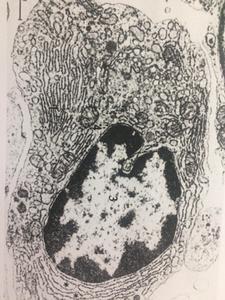18571476
Chapter 7
Resumo de Recurso
Questão 1
Questão
Which of the following currents is responsible for the depolarization phase of the axonal action
potential?
Responda
-
a) inward sodium ion current;
-
b) inward potassium ion current;
-
c) outward calcium ion current.
Questão 2
Questão
Which of the following currents is responsible for the repolarization phase of the axonal action
potential?
Responda
-
a) inward sodium ion current;
-
b) inward calcium ion current;
-
c) outward potassium ion current.
Questão 3
Questão
Choose the correct statement:
Responda
-
a) action potentials propagate without attenuation (decrease) of amplitude and with relatives constant speed;
-
b) action potentials propagate with significant decrease of amplitude over the length of the membrane;
-
c) action potentials propagate with increase of the amplitude over the length of the membrane.
Questão 4
Questão
Which of the following factors affects the speed of propagation of axonal action potentials?
Responda
-
a) diameter and myelination;
-
b) only the diameter of the axon;
-
c) the length of the axon.
Questão 5
Questão
Sodium equilibrium potential (ENa+) for typical neurons is about:
Responda
-
a) +45 mV;
-
b) - 90 mV;
-
c) +95 mV.
Questão 6
Questão
The depolarization phase in typical neurons is due to:
Responda
-
a) Na+ ions;
-
b) Na+ and Ca2+ ions;
-
c) Ca2+ ions.
Questão 7
Questão
The equilibrium potential of which of the following ions is the closest to the membrane resting
potential?
Responda
-
a) Na+ ;
-
b) Ca2+;
-
c) K+
Questão 8
Questão
Treatment of tissue with tetrodotoxin (TTX) will result in:
Responda
-
a) change of the sodium equilibrium potential;
-
b) change in the extracellular sodium concentration;
-
c) inhibition of passive sodium transport.
Questão 9
Questão
Treatment of tissue with tetraethylammonium (TEA) will result in:
Responda
-
a) change of the potassium equilibrium potential;
-
b) inhibition of active potassium transport;
-
c) inhibition of passive potassium transport.
Questão 10
Questão
What makes the membrane resting potential so close to the potassium equilibrium potential?
Responda
-
a) leak potassium channels and low membrane permeability for other ions;
-
b) the much higher potassium concentration inside the cell compared to other ions;
-
c) the work of the sodium-potassium pump which balances the outward leak of potassium.
Questão 11
Questão
What is represented on the graph on the right?
Responda
-
a) the evolution of total membrane current during the course of the action potential;
-
b) the inward Na+ current during the course of the action potential;
-
c) the outward K + current during the course of the action potential.
Questão 12
Questão
For their experimental model Hodgkin and Huxley used the method of the:
Responda
-
a) generated voltage;
-
b) fixed voltage;
-
c) sinusoidal voltage.
Questão 13
Questão
The equation gNa = 1/RNa describes:
Responda
-
a) sodium membrane conductance;
-
b) sodium membrane current;
-
c) sodium membrane voltage.
Questão 14
Questão
Membrane conductance for Na+
and K
+
ions is not constant. It depends on:
Responda
-
a) the strength of the sub-threshold stimulus;
-
b) the state of the voltage-gated ion channels;
-
c) the state of the leak ion channels.
Questão 15
Questão
The depolarization phase of the axonal action potential is contributed to the:
Responda
-
a) inward Na+ current due to the electrogenic work of the sodium-potassium pump;
-
b) inward Na+ current due to the non-electrogenic work of the sodium-potassium pump;
-
c) inward Na+ current due to the activation of voltage-gated sodium channels.
Questão 16
Questão
The repolarization phase of the axonal action potential is contributed to:
Responda
-
a) the outward K + current due to potassium leak channels;
-
b) the outward K + current due to the activation of voltage-gated potassium channels;
-
c) the outward K + current due to the electrogenic work of the sodium-potassium pump.
Questão 17
Questão
What happens when the membrane potential in neurons becomes equal or greater than the
critical depolarisation threshold?
Responda
-
a) voltage gated Na+ channels become deactivated, and the membrane potential returns to its resting state;
-
b) voltage-gated Na+ channels do not respond to changes in the membrane potential reaching the critical threshold depolarization level;
-
c) voltage-gated Na+ channels open and action potential is initiated.
Questão 18
Questão
What kind of ion current flows across the axonal membrane during the repolarization phase of
the action potential?
Responda
-
a) negative Na+ current;
-
b) positive Na+ current;
-
c) positive K + current.
Questão 19
Questão
During the voltage clamp method, the voltage across the membrane is fixed and the current
passing through the membrane is measured:
Responda
-
a) directly, using sensitive voltmeter across the membrane;
-
b) indirectly, by the input current required to keep the voltage fixed;
-
c) current is not measured but calculated using Ohm’s law.
Questão 20
Questão
During the resting state of the axonal membrane the ratio of the ion permeabilities for potassium
and sodium is PK : PNa = 1 : 0.04. During the depolarization phase of the action potential this ratio
changes as follows:
Responda
-
a) PK : PNa = 1 : 0.0004;
-
b) PK : PNa = 1 : 20;
-
c) PK : PNa = 20 : 0.04.
Questão 21
Questão
A common property of “excitable" cells are:
Responda
-
a) the voltage-gated ion channels of the cellular membrane;
-
b) the Na+/K+ pumps of the cellular membrane;
-
c) the membrane specialisation for communication via neurotransmitters and hormones.
Questão 22
Questão
What type of ion current does not pass through membrane treated with 10-5 M of TEA
(tetraethylammonium)?
Responda
-
a) Na+ influx;
-
b) Na+ efflux;
-
c) K + efflux.
Quer criar seus próprios Quizzes gratuitos com a GoConqr? Saiba mais.

